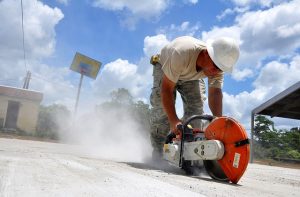Print a Sign-In Sheet | Spanish Version Coming Soon
What is Silicosis?
 Crystalline silica is a common element found in sand, concrete, rock, granite, quartz, mortar, and brick and these items are common materials found on construction sites. A number of industries may be exposed to crystalline silica but construction workers have the highest potential exposure due to the operations they perform. When construction workers chip, grind, cut, drill, blast, or dump materials that contain crystalline silica, they produce a crystalline silica dust. When unprotected workers breathe in crystalline silica dust, they may cause serious damage to their lungs and may expose themselves to a disabling and often fatal disease called silicosis.
Crystalline silica is a common element found in sand, concrete, rock, granite, quartz, mortar, and brick and these items are common materials found on construction sites. A number of industries may be exposed to crystalline silica but construction workers have the highest potential exposure due to the operations they perform. When construction workers chip, grind, cut, drill, blast, or dump materials that contain crystalline silica, they produce a crystalline silica dust. When unprotected workers breathe in crystalline silica dust, they may cause serious damage to their lungs and may expose themselves to a disabling and often fatal disease called silicosis.
Possible Symptoms of Silicosis:
- Shortness of breath
- Coughing
- Fatigue
- Loss of appetite
- Fever
- Weight loss
- Chest pain
- Respiratory problems (that may not be reversible)
- Lung damage that can eventually lead to death
- Initially there may be no symptoms from exposure to silica dust, but over time these symptoms may progress into more aggressive symptoms and become permanent.
Ways Employees May Be Exposed:
- Abrasive blasting using silica sand
- Blasting of concrete
- Crushing, chipping, drilling, hammering, cutting of rock and concrete
- Masonry and concrete work
- Demolition work
- Dry sweeping or pressurized air blowing of concrete, rock dust, or sand dust
Possible Ways to Prevent Silicosis:
- Use all available engineering and work practice controls to reduce or eliminate the exposure to crystalline silica dust. OSHA has established a Permissible Exposure Limit (PEL), which is the maximum amount of crystalline silica an employee may be exposed to during an 8-hour work shift. (29 CFR 1926.55-Construction or 29 CFR 1910.1000-General Industry)
- Replace or substitute crystalline silica material with a safer material whenever possible. Try not to use sand or other substances containing more than 1% crystalline silica when performing abrasive blasting.
- Always use a dust control system. Vacuums and water sprays help reduce or eliminate dust at the source before it becomes airborne.
- Wear only a N95 NIOSH certified respirator, if respiratory protection is needed. Wear only Type CE abrasive-blast supplied-air respirators for abrasive blasting.
- Wear clothing that is disposable or washable and shower if facilities are available. Change into clean clothing before leaving the worksite.
- Do not eat, drink, or smoke in areas where crystalline silica dust is present. Wash your face and hands before performing any of these activities. Smoking adds to lung damage caused by silica dust exposure.
- Be aware of operations and jobs creating crystalline silica dust exposure in your workplace/jobsite. Minimize exposure to nearby workers by using good work practices.
- Participate in training, monitoring, and health screening programs to better understand the exposures and risks of crystalline silica dust.
- Remember: If there is no visible dust, you could be at risk. If there is visible dust, you are almost definitely at risk.
KEMI does not assume liability for the content of information contained herein. Safety and health remain your responsibility. This information is to be used for informational purposes only and not intended to be exhaustive or a substitute for proper training, supervision or manufacturers’ instructions/recommendations. KEMI, by publication of this information, does not assume liability for damage or injury arising from reliance upon it. Compliance with this information is not a guarantee or warranty that you will be in conformity with any laws or regulations nor does it ensure the absolute safety of any person, place or object, including, but not limited to, you, your occupation, employees, customers or place of business.

